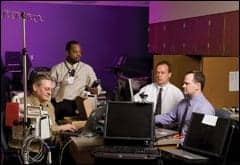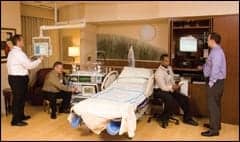 |
| L-R, Jeff Johnson; Marcus C. Harris; Terrence D. Baker, manager, information systems; Timothy S. Huffman, clinical engineering supervisor. |
It is not a new concept: there has been chatter about increased, deliberate collaboration between information services (IS)—or information technology—and clinical engineering departments for years, yet few have made the commitment.
So, in 2005, when Clarian North Medical Center, Indianapolis, was prepping to open its doors, it was not necessarily a given that the two teams would blend their strengths. But as the latest technology started filling the 170-bed hospital, it became clear that the lines dividing IS from clinical engineering were not just getting blurry, but were rapidly disappearing.
“When we started installing MRI units and clinical-focused PCs onto the network, we realized that there was a need for a lot of IS help in getting the systems operational,” says Terrence D. Baker, manager, information systems. With each device, he says it became increasingly obvious that not working together would have led to last-minute complications.
To streamline not only the setup of machines, but the ongoing maintenance and repair required once the facility was up and running, the decision was made to have Clarian North’s clinical engineering team report to Baker.
“It wasn’t solely my idea, but it was during this process that I took to it,” he says. “Being a new organization, we weren’t held with a lot of old constraints, and the attitude was, ‘Let’s try it, and if it doesn’t work, we can always go back to the more classic reporting structure.’ “
Timothy S. Huffman echoes those sentiments. Bringing more than a decade of experience in the industry to the role of Clarian North’s clinical engineering supervisor, Huffman quickly took note of the volume of systems tied into the hospital’s network.
“I was in a pretty old hospital in my last position, and when I came here it was just ridiculous the amount of stuff IS and clinical engineering worked together on,” he says. He adds that, at the start of his career, clinical engineering was closely linked with facilities far more often than it was with IS. “But as we started to work with IS more at Clarian North, I can see that the balance is shifting. Facilities and I spent a matter of hours dividing up what was going to be their responsibility and what was going to be ours, whereas Terry and I do that on a weekly basis.”
Those discussions include everything from selecting new pieces of equipment to which people are best suited to handle tasks as they come up.
“Organizing our department this way makes complete sense,” Huffman says, because it makes easy work of identifying and assigning the appropriate resources for every job.
 |
| According to Huffman, biomeds and IS are all trying to achieve the same goal: to implement technology and equipment within the patient environment. |
Putting Pieces In Place
With a corporate flowchart in place, the next piece of the puzzle was identifying the ultimate owner as either IS or clinical engineering for each device within the hospital.
“There are essentially two words that qualify something as a clinical engineering device,” Huffman says. “That is, do they ‘treat’ or ‘diagnose?’ If something provides therapy or diagnoses the patient, then it is typically going to be a clinical engineering device, with a lot of IS support.”
This is true even on systems that, at first glance, appear to be IS-based. “Even if it has a lot of components that need to be networked, if that system is going to touch a patient and it is part of patient care, it is really clinical,” Baker says. “It needs to be owned by the clinical engineers, because they understand that world better than an IS person does.” Baker quickly adds that this is not to imply that the biomed must tackle jobs solo. “Often, this means that the clinical engineer, while taking lead on a project, pulls in an IS person to help.”
In the existing structure, the clinical engineering tech will take ownership of the system, knowing they are able to rely on their counterparts when necessary. “They feel comfortable that they have IS people there, ready to come in and help them with those components,” Baker says.
Getting the clinical engineering staff to buy into the new structures was not a tough sell and was quite the opposite, in fact. For a seasoned biomed, it was a welcome change.
“It’s quite refreshing,” says Marcus C. Harris, BMET II. “At other places I’ve worked, it was always something of a hassle to find the right people in IS when you needed help with something. Whereas here, we work together; we know everybody, what they do, and how they can help us.”
Which is not to say there isn’t a learning curve for techs getting acclimated to the innovative structure. Huffman notes that, on occasion, biomeds will ask whether a job is their responsibility or if it should fall to “Terry’s guys.”
“I remind them that we are all Terry’s guys,” Huffman says. “We all report to IS and are part of the same group. The question is more a matter of if a job is going to be best handled on the IS side or the clinical engineering side.”
This united front is not only communicated within the department. A single phone number to call has been established for their clients. As much as possible, all calls placed are routed to the appropriate owner for the job. Merging the front-end support in this way has proven extremely helpful to the clinicians.
“This technology is starting to all look the same to the end user,” Baker says. “It’s a keyboard and monitor sitting there, so they assume it must be IS. Which makes it even more important for the IS guy, if he determines it’s a system owned by clinical engineering, to feel very comfortable engaging his partners on the clinical engineering team.” He credits part of the success of this new model on the fact that the managers encourage teaming up on projects. “The IS tech shouldn’t then just pawn the job off to the clinical engineering guy. He should stay there in case there are problems he can help resolve.”
Baker gives the fetal monitoring system issues as an example. If a representative from clinical engineering, which owns the system, assesses the situation and determines the sources of trouble is a networking issue, he will call an IS tech to investigate. But, he will also stay engaged in the project, ready to help with any issues that may come up.
“We really try and promote a sense of ownership, getting away from divisions and eliminating the mind-set of, ‘well, that’s not mine, so I’m going to punt it in your direction and then take off,’ ” Baker says. “Everybody in our department has a sense of ownership. Everybody understands who the primary is on each piece of technology, but at the same time, no one feels like they are unwelcome in that world.”
That level of acceptance comes into play with every aspect of the hospital’s infrastructure, including access to secure networks.
“At another hospital where I worked, anything that dealt with the PACS system or PACS workstations was password protected, and they did not provide any access to us,” Harris says, whose current areas of responsibility include the radiology department. “We were completely out of the loop, but here, I have appropriate access to conduct first-look troubleshooting. If radiology has any problems with the unit or stations—even just a PACS viewing station—we take first look. I have the access I need to diagnose the problem and take care of it.”
The access not only allows for biomeds to fulfill their job duties, but it shifts the focus from “who is responsible” to “let’s get this fixed,” according to Harris. “We work together to completion,” he says. “Our goal is to make sure the patient and our nurses and staff are taken care of.”
Highlighting Strengths
No special effort has been made to create “hybrid” IS/clinical engineering employees. And while there aren’t any plans to create a formal type of cross-training program, all of the employees are benefiting from exposure to the other side of the industry.
“I was surprised at the amount of technology we have to deal with on a regular basis,” says Jeff Johnson, BMET II, who started working for Clarian North during the preopening preparation phase. “I know a lot more about computers now than I did before working here.” Just one case of this on-the-job exposure to the IS world is in surgery, where physicians use a number of monitors during the operation—all of which are controlled by myriad PCs and switches, according to Johnson.
Despite its network-driven structure, the system’s role in patient treatment means it is defined as a clinical engineering-owned system. As a result, biomeds are getting hands-on time with the technology.
“When graphic cards go bad, we will go in and replace them,” Johnson says. “We really dig into that type of work, which has been a good learning experience.” He adds that he welcomes such opportunities to increase his skill set. “Everything is becoming very computer- and network-based. It is good to stay current.”
And while Baker encourages everyone on his team to take advantage of this type of cross-industry knowledge, he is not out to change how people operate within their own fields. “All of our biomeds end up obtaining a solid familiarity with the technology. They are comfortable with and understand it, but we don’t need to make a clinical engineering guy become an expert on servers or networks,” he says. “Why do that when we can bring those resources in by calling another member of the team?”
Harris hits a balance between the two worlds. With degrees in both biomedical engineering technology and electrical engineering technology, he plays an active role in maintaining open channels between the IS and clinical engineering crews.
“There is definitely not an ‘us versus them’ mind-set here,” Harris says. “We have very open communications with IS.” He sees a great benefit to their joint staff meetings and says, “When all of the biomed shop and all of the IS staff get together like that, it gives us an opportunity to discuss any problem situations that exist and to work together for the best solution.”
Beyond collaborating on specific assignments, the IS techs and biomeds even share meals, a simple act that is unheard of in facilities embroiled in ongoing turf wars between the two departments. While the social interaction is always good for job satisfaction, it is just one more way the two teams work to erode any discomfort between the different job descriptions.
“We spend a lot of time with the IS guys, and we have lunch together probably 4 out of 5 days a week,” Johnson says. “A lot of times, we will just ask each other questions and discuss projects during lunch. It is a very casual relationship. If I have a problem, or if I need a data cable or other piece of equipment, I have no problem going over to their shop and asking one of their techs.”
Brave New World
Transitioning to this type of combined IS/clinical engineering structure is not easy for everyone. It is a change for everybody, even the IS professionals who, in recent years, have watched their own field change.
“If you go back a number of years, IS departments in hospitals were doing the same things they were doing at a shipping company or at a financial firm: they were worrying just about the business of the hospital,” Baker says. “So this has also been a transformation for IS as well. They’ve seen technology creep more on its own into the clinical world, and now they are expected to deliver service right at the bedside.”
This increases not only the need for biomeds to become more familiar with technology, but for IS teams to truly understand the clinical part of the hospital. The key to helping these two professions meet in the middle is solid leadership, according to Baker.
“Some people may be a little less likely to embrace learning more about the technology, so to make it work, your leadership has to be on board,” he says. “If you set this expectation and show no trepidation about it, your people pick up on that and buy into it.”
Working together and combining existing strengths routinely provides solutions at Clarian North. One of the most recent displays of this is the development of workstations on wheels (WOW) for the hospital’s cath lab. Clinicians were requesting a portable unit that allowed them to share with families the patient’s cardiac study, directly from the cath lab. Making it happen would require equipment on rolling carts that connected remotely and wirelessly to the hospital network, so it would be possible to pull diagnostic-quality images from the cath lab and display them on a 17-inch, high-end viewing monitor.
Baker’s observations about the task, including the fact that it was “pretty straightforward,” draws a chuckle from Huffman.
“He said, ‘It’s fairly easy,’ but that’s from his perspective,” Huffman says. “This is an application that clinical engineering owns, but without Terry’s expertise, we would not have gotten this done. This was the type of job that IS definitely needed to do, because no one in our clinical engineering department, including me, could have done this so easily. It is proof of the need for us to work together and blend our skills.”
Baker adds that these types of requests that require the know-how of both IS and clinical engineering will continue to grow as technology advances.
“Physicians are now so used to the technology, and they expect us to be able to do things like the WOW carts,” Baker says. “A doctor will ask if he can remotely show studies to patients, just as if he’s asking for a cup of coffee. Yet, for clinical engineering, it was a hurdle.” The IS team, however, was familiar with what technology was available and were able to lend a hand, getting the desired application running on the wireless carts. “It was also a very fulfilling thing to do, to empower our physicians to educate a family as much as possible, and hopefully give them a sense of comfort and understanding about what might be going on with their family member.”
Collaborative Success
Pooling efforts to make all projects simple and a reality helps drive home the importance of collaboration for the biomeds at Clarian North. It also illustrates why tensions between IS and clinical engineering would best be relegated to the archives.
“When you talk about turf wars, that is often generated by fear of becoming unnecessary,” Baker says. “But the technology is just growing and growing within this field. There is plenty of work for anyone that is willing to embrace it.”
Huffman agrees. “The biomed field is changing significantly,” he says. “Not just moving toward IS, but also the types of repairs and the depth of repairs we are performing have decreased significantly. Most of the time when we find a problem, we isolate it to the board level; we no longer have to go in and change out board components.” He adds that technology management is becoming more important for biomeds, so they can review new systems and help hospitals identify which ones should be adopted. “There is a kind of merging of the two professions, because really, we are all trying to achieve the same goal: to implement technology and equipment within the patient environment.”
Baker believes embracing this industry shift is the key to continued professional relevance. “When you leverage all of your resources and become very efficient by doing the job right, you open up opportunities to do even more—and to do it better,” he says.
Dana Hinesly is a contributing writer for 24×7. For more information, contact .




